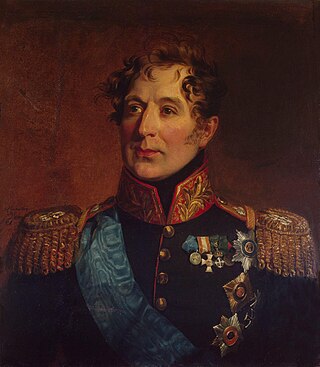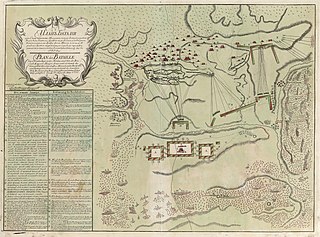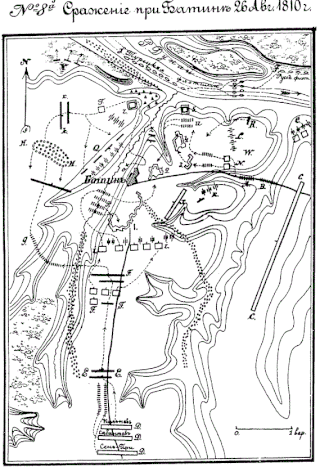
Prince Pyotr Ivanovich Bagration was a Russian general and prince of Georgian origin, prominent during the French Revolutionary and Napoleonic Wars.

The Battle of Borodino took place near the village of Borodino on 7 September [O.S. 26 August] 1812 during Napoleon's invasion of Russia. The Grande Armée won the battle against the Imperial Russian Army, but failed to gain a decisive victory and suffered tremendous losses. Napoleon fought against General Mikhail Kutuzov, whom the Emperor Alexander I of Russia had appointed to replace Barclay de Tolly on 29 August [O.S. 17 August] 1812 after the Battle of Smolensk. After the Battle of Borodino, Napoleon remained on the battlefield with his army; the Imperial Russian forces retreated in an orderly fashion southwards. Because the Imperial Russian army had severely weakened the Grande Armée, they allowed the French occupation of Moscow, using the city as bait to trap Napoleon and his men. The failure of the Grande Armée to completely destroy the Imperial Russian army, in particular Napoleon's reluctance to deploy his Imperial Guard, has been widely criticised by historians as a huge blunder, as it allowed the Imperial Russian army to continue its retreat into territory increasingly hostile to the French.

The Russo-Turkish War (1806–1812) between the Russian Empire and the Ottoman Empire was one of the Russo-Turkish Wars. Russia prevailed, but both sides wanted peace as they feared Napoleon's moves to the east.

The Battle of Smolensk was the first major battle of the French invasion of Russia. It took place on 16–18 August 1812 and involved about 45,000 men of the Grande Armée under Emperor Napoleon I against about 30,000 Russian troops under General Barclay de Tolly. Napoleon occupied Smolensk by driving out Prince Pyotr Bagration's Second Army. The French artillery bombardment burned the city to the ground. Of 2,250 buildings, 84% were destroyed with only 350 surviving intact. Of the city's 15,000 inhabitants, about 1,000 were left at the end of the battle inside the smoking ruins. With over 15,000 casualties, it was one of the bloodiest battles of the invasion.

Count Mikhail Andreyevich Miloradovich, spelled Miloradovitch in contemporary English sources, was a Russian general prominent during the Napoleonic Wars. On his father’s side, Miloradovich descended from the Serb noble family and the katun clan of Miloradović from Hum, later part of Sanjak of Herzegovina, in present-day Bosnia and Herzegovina. He entered military service on the eve of the Russo-Swedish War of 1788–1790 and his career advanced rapidly during the reign (1796-1801) of Emperor Paul I. He served under Alexander Suvorov during Italian and Swiss campaigns of 1799. Miloradovich was, along with Pyotr Bagration, a brilliant pupil of Suvorov, and became one of the outstanding figures in the military history of Russia.

Count Matvei or Matvey Ivanovich Platov was a Russian general who commanded the Don Cossacks in the Napoleonic wars and founded Novocherkassk as the new capital of the Don Host Province.

The Battle of Krasnoi unfolded from 15 to 18 November 1812 marking a critical episode in Napoleon's arduous retreat from Moscow. Over the course of six skirmishes the Russian forces under field marshal Kutuzov inflicted significant blows upon the remnants of the Grande Armée, already severely weakened by attrition warfare. These confrontations, though not escalated into full-scale battles, led to substantial losses for the French due to their depleted weapons and horses.

The siege of Izmail or Ismail / Ishmael / İzmail, also called the storming of Izmail, was a military action fought in 1790 on the Black Sea during the Russo-Turkish War (1787–1792) and simultaneously the Austro-Turkish War (1788–91). The Russians were led by Alexander Suvorov, who had defeated the Ottomans at Kinburn, Focsani, and Rymnik, as well as participating in the siege of Ochakov. The Black Sea rowing flotilla was commanded by the Spanish admiral José de Ribas. It is regarded as one of Suvorov's finest victories and one of the greatest deeds in world military history.

The Battle of Stavuchany was fought between the Russian and Ottoman armies, which took place on August 28 (17) of 1739 during the Russo-Turkish War of 1735-1739.

The Battle of Vyazma, occurred at the beginning of Napoleon's retreat from Moscow. In this encounter a Russian force commanded by General Miloradovich inflicted heavy losses on the rear guard of the Grande Armée. Although the French thwarted Miloradovich's goal of encircling and destroying the corps of Marshal Davout, they withdrew in a partial state of disorder due to ongoing Russian harassment and heavy artillery bombardments. The French reversal at Vyazma, although indecisive, was significant due to its damaging impact on several corps of Napoleon's retreating army.

The Battle of Schöngrabern, also known as the Battle of Hollabrunn, was an engagement in the Napoleonic Wars during the War of the Third Coalition, fought on 16 November 1805 near Hollabrunn in Lower Austria, four weeks after the Battle of Ulm and two weeks before the Battle of Austerlitz.

The Battle of Măcin, Battle of Maçin, Battle of Matchin or Battle of Matschin took place during the Russo-Turkish War (1787–1792), fought on 9 July 1791 between the Ottoman Empire and the Russian Empire. The Russian army of 30,000 was commanded by Prince Nicholas Repnin, whereas the Turks, numbering about 80,000 men, were led by Koca Yusuf Pasha.

The Battle of Amstetten was a minor engagement during the War of the Third Coalition between the First French Empire and the alliance of Austria and Russia. It occurred on 5 November 1805, when the retreating Russo-Austrian troops, led by Mikhail Kutuzov, were intercepted by Marshal Joachim Murat's cavalry and a portion of Marshal Jean Lannes' corps. Pyotr Bagration defended against the advancing French troops and allowed the Russian troops to retreat. This was the first fight in which a major part of the Russian Army opposed a significant number of French troops in the open. The total number of Russo-Austrian troops was around 6,700, while the French troops numbered roughly 10,000 troops. The Russo-Austrian forces suffered more casualties but were still able to successfully retreat.

The French invasion of Russia, also known as the Russian campaign and in Russia as the Patriotic War of 1812, was initiated by Napoleon with the aim of compelling the Russian Empire to comply with the continental blockade of the United Kingdom. Widely studied, Napoleon's incursion into Russia stands as a focal point in military history, recognized as among the most devastating military endeavors globally. In a span of fewer than six months, the campaign exacted a staggering toll, claiming the lives of nearly a million soldiers and civilians.

The siege of Silistria, or siege of Silistra, took place during the Crimean War, from 11 May to 23 June 1854, when Russian forces besieged the Ottoman fortress of Silistria. Sustained Ottoman resistance had allowed French and British troops to build up a significant army in nearby Varna. Under additional pressure from Austria, the Russian command, which was about to launch a final assault on the fortress town, was ordered to lift the siege and retreat from the area, thus ending the Danubian phase of the Crimean War.

This is the order of battle of the French invasion of Russia.

The Battle of Slobozia was fought between Russia and the Ottoman Empire as a part of the Napoleonic Wars during the Russo-Turkish War of 1806–1812. The primary battle occurred on the left bank of the Danube River near the small village of Slobozia in Wallachia. Four miles to the southeast on the right bank of the Danube was the Ottoman fortress at Rusçuk. The Russian investment of the Ottoman forces at Slobozia including the final battle lasted approximately two and half months from 28 August to 14 November 1811, ending when Russian Commander Mikhail Kutuzov ultimately accepted the surrender of the Ottoman forces commanded by Ahmed Pasha.

The Battle of Batin took place on 9 September 1810 near the small town of Batin, north Bulgaria during the Russo-Turkish War of 1806 to 1812. The conflict involved an attack by Russian forces on a defensive position held by a numerically stronger Ottoman force. The outcome was a Russian victory which enabled their ongoing Balkan campaign to proceed unhindered.

Fedor Sergeyevich Panyutin was a Russian general, Warsaw military governor, and member of the State Council. During the Hungarian Revolution of 1848, he rendered pleasant service under the able Austrian commander Julius Jacob von Haynau, as well as at Pered.

The siege of Anapa or the storming of Anapa was a siege that took place on July 3, 1791, when the Russian Empire attacked the Turkish-regulated Anapa fort in Circassia as part of the Russo-Turkish War and the Russo-Circassian War.




















